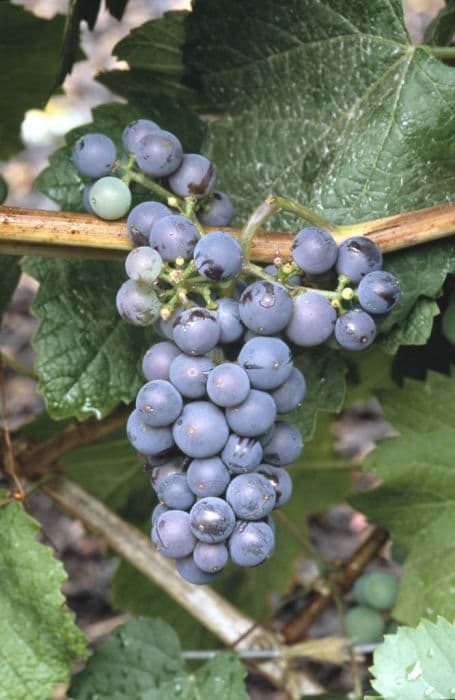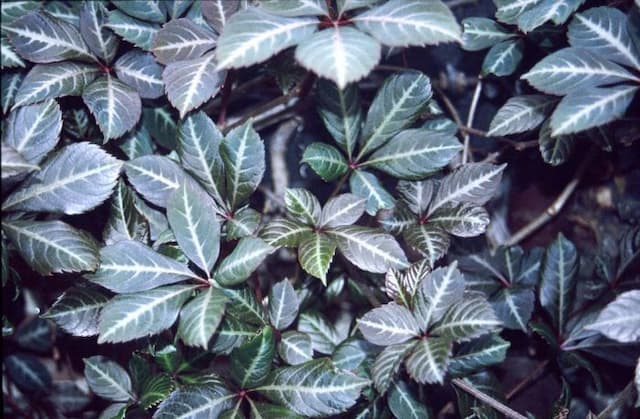Boskoop Glory Grape Vitis 'Boskoop Glory' (O/b)

ABOUT
Vitis 'Boskoop Glory' is commonly known as a grape vine, and it is recognized for its ornamental values as well as its fruit production. The plant boasts broad green leaves that have a distinctive lobed shape, typical to grape vines, often with jagged edges which may have hints of red or yellow, especially as the leaves mature. Come springtime, the grape vine produces inconspicuous flowers that later develop into clusters of grapes. These grapes are usually dark blue or black, often with a dusty-white bloom on their surface, and are tightly packed together in bunches that dangle attractively from the vine. The bark of older stems may appear gnarled and woody, providing a rustic look that contrasts with the lush foliage. The tendrils of the grape vine, which it uses to climb and support itself, are thin and curly, reaching out to grasp onto structures or other plants.
About this plant
 Names
NamesSynonyms
Boskoop Glory Grape, Boskoop Glory Vine
Common names
Vitis 'Boskoop Glory'
 Toxicity
ToxicityTo humans
Grape (Vitis 'Boskoop Glory') is not toxic to humans when it comes to consumption of the ripe fruit; grapes are commonly eaten. However, other parts of the plant, such as the leaves and stems, contain chemical compounds which may be irritating if eaten in large quantities or if one has a particular sensitivity. It's uncommon for the non-fruit parts of the grape to be ingested by humans, so poisoning is rare. Ingesting significant amounts could possibly cause nausea, diarrhea, and vomiting.
To pets
Grape (Vitis 'Boskoop Glory') is toxic to dogs and cats. The consumption of grapes (and raisins, which are dried grapes) can lead to acute kidney failure in pets. Symptoms of grape or raisin poisoning may include vomiting, diarrhea, lethargy, abdominal pain, decreased appetite, and subsequent kidney failure. There can be variability in the toxic dose and some animals may be more sensitive than others. Pet owners should avoid feeding grapes to their animals and seek veterinary care immediately if ingestion is suspected.
 Characteristics
CharacteristicsLife cycle
Perennials
Foliage type
Deciduous
Color of leaves
Green
Flower color
Greenish-yellow
Height
4-6 feet (1.2-1.8 meters)
Spread
3-5 feet (0.9-1.5 meters)
Plant type
Climber
Hardiness zones
5-9
Native area
Europe
Benefits
 General Benefits
General Benefits- Easy Cultivation: 'Boskoop Glory' is known for being an easy grape variety to grow, suitable for beginner gardeners.
- Ornamental Value: With its attractive foliage and vines, it can enhance the aesthetic appeal of any garden space.
- Shade Provision: The dense canopy of vines can provide a natural shade area in gardens and outdoor spaces.
- Fruit Production: It produces edible grapes that can be eaten fresh or used in making wines, jellies, and juices.
- Pollinator Attraction: The flowers attract bees and other pollinators, supporting local ecosystems.
- Seasonal Interest: Offers visual interest throughout the seasons with spring blooms, summer fruits, and colorful fall foliage.
- Screening Plant: Can be used to create natural screens for privacy or to hide unsightly areas in the landscape.
- Wildlife Habitat: Provides shelter and potential food sources for birds and other wildlife.
- Erosion Control: The root system can help stabilize soil and prevent erosion on slopes or banks.
- Versatility: Can be grown in containers or trained along fences, trellises, or arbors to suit different garden designs.
 Medical Properties
Medical Properties- This plant is not used for medical purposes.
 Air-purifying Qualities
Air-purifying QualitiesThis plant is not specifically known for air purifying qualities.
 Other Uses
Other Uses- As a natural dye: The skins of 'Boskoop Glory' grapes can be used to create natural dyes for fabrics, yielding shades of blue or purple depending on the mordant used.
- In artisan crafts: Dried tendrils and vines from the grape plant can be woven into baskets, wreaths, or used as decorative elements in floral arrangements.
- As a shade provider: The vine can be trained over pergolas or arbors to create natural shaded areas in gardens or patios.
- In landscaping: 'Boskoop Glory' can be used as a cover for unsightly fences or walls, adding a touch of greenery and the potential for seasonal color changes.
- Grape leaf sachets: Dried grape leaves can be used to create aromatic sachets that add a subtle fragrance to drawers and closets.
- As a living art medium: Creative gardeners can train the vines to grow in specific shapes or patterns for unique garden installations or "living sculptures."
- For composting: Fallen leaves and pruned vines can be composted to create nutrient-rich soil amendments for garden use.
- In photography: The plant's aesthetic foliage and fruit clusters can serve as vibrant subjects for botanical photography.
- In culinary presentations: Large grape leaves can be used as natural platters or decorative garnishes for cheese boards and other appetizers.
- For educational purposes: The plant can be employed in schools or educational programs to teach about the life cycle of plants, photosynthesis, and grapevine cultivation.
Interesting Facts
 Feng Shui
Feng ShuiThe grapevine is not used in Feng Shui practice.
 Zodiac Sign Compitability
Zodiac Sign CompitabilityThe grapevine is not used in astrology practice.
 Plant Symbolism
Plant Symbolism- Fertility: As a grape-bearing vine, Vitis 'Boskoop Glory' often symbolizes fertility due to its abundant fruit production.
- Abundance: This plant can produce clusters of grapes, which are emblematic of abundance and plenty.
- Vitality: The vigor with which grapevines grow is frequently associated with robustness and a strong life force.
- Transformation: Grapes undergo a process of transformation to become wine, which can represent personal growth or spiritual evolution.
- Celebration: Wine made from grapes is commonly associated with festivities and merrymaking, making the grapevine a symbol of joy and celebration.
 Water
WaterGrapevines such as Boskoop Glory typically require deep watering to promote a strong root system, especially during their growing season. Water young plants with about 1 gallon of water per week. Mature grapevines may need up to 4 gallons per week during peak growing season if there is no significant rainfall. Reduce watering in the late fall and winter months when the plant is dormant. Water the plant at the base to avoid wetting the foliage, which can lead to fungal diseases.
 Light
LightBoskoop Glory grapevines thrive best in full sun conditions, needing a minimum of 6-8 hours of direct sunlight per day. The ideal spot for these grapevines is an open area away from shade-causing structures or trees. Full sun exposure is crucial for fruit development and ripeness.
 Temperature
TemperatureBoskoop Glory grapevines prefer a temperature range between 55°F to 85°F for optimal growth. They can survive minimum temperatures down to about 20°F in winter dormancy. Avoid exposing the plant to temperatures over 95°F, which can stress the vines and affect fruit production.
 Pruning
PruningPrune Boskoop Glory grapevines to maintain vine structure, improve sunlight exposure and airflow, and encourage fruit production. Pruning is best done during the dormant season, usually late winter to early spring. Remove dead, damaged, or diseased wood, and thin out crowded areas. Prune annually to manage the size and shape of the vines.
 Cleaning
CleaningAs needed
 Soil
SoilThe Boskoop Glory grapevine prefers a soil mix rich in organic matter with good drainage. A blend of loamy soil, compost, and perlite or sand to enhance drainage is ideal. This grapevine variety thrives in a soil pH range of 5.5 to 6.5.
 Repotting
RepottingBoskoop Glory grapevines grown in containers should be repotted every 2-3 years, or when they outgrow their current pots, to ensure they have enough space for root growth and nutrient availability.
 Humidity & Misting
Humidity & MistingBoskoop Glory grape enjoys moderate humidity levels but is quite adaptable and can tolerate the lower humidity levels typically found outdoors in temperate climates.
 Suitable locations
Suitable locationsIndoor
Provide full sun, well-drained soil, and a sturdy support for climbing.
Outdoor
Plant in full sun, train on trellis, and maintain well-draining soil.
Hardiness zone
5-9 USDA
 Life cycle
Life cycleVitis 'Boskoop Glory', commonly known as grapevine or Boskoop Glory grape, starts its life cycle with seed germination or vegetative propagation through cuttings. After rooting, a young vine (a process that can take a full growing season), it enters a period of rapid vegetative growth where stems, leaves, and tendrils develop. The grapevine reaches maturity in 2-3 years, when it begins to produce flower clusters that are pollinated, leading to the development of grape berries. Seasonally, the plant goes through a growing season with active photosynthesis in spring and summer, and then a dormant period in autumn and winter when leaves fall and vines become woody. It undergoes annual cycles of growth, flowering, and fruiting, typically being pruned during dormancy to maintain vine shape and promote productive growth in the next season. Finally, after many years, the grapevine may eventually decline in vigor and fruit production, which is when growers often choose to replant.
 Propogation
PropogationPropogation time
Spring-Early Summer
The most popular method for propagating Vitis 'Boskoop Glory', commonly known as a variety of grapevine, is by hardwood cuttings. This process typically begins in late fall after the leaves have dropped, or in early spring before bud break. You take a cutting of about 12 to 18 inches (30 to 45 cm) from a healthy, dormant cane that has several buds. The cutting should be made just below a bud at the base and at an angle just above a bud at the top, which helps to remember which end is up and also helps to prevent water from accumulating on the top cut surface. The cuttings are then buried in moist sand or soil with a couple of buds above the surface and kept in a cool place until roots have developed, after which they can be planted in their permanent location.









